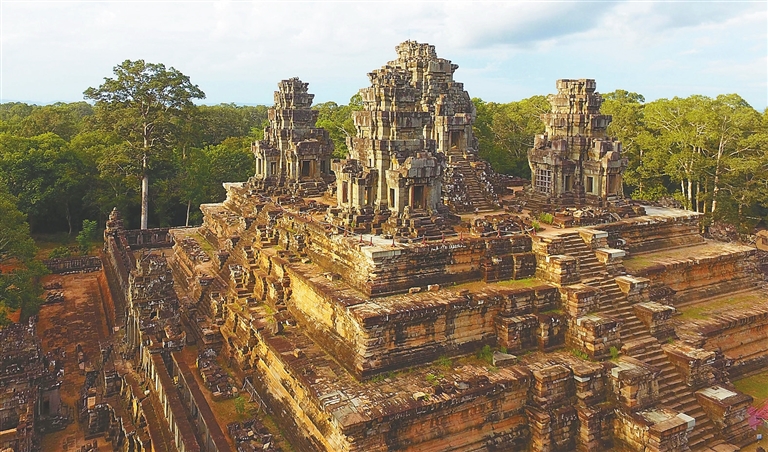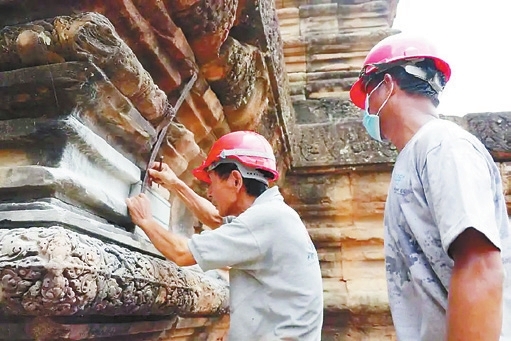

A CEREMONY marking the handover of the Ta Keo Temple restored with Chinese assistance was held Nov. 10 in Siem Reap, Cambodia. The temple is one of hundreds of stone monuments that make up the Angkor World Heritage, which contains the magnificent remains of different capitals of the Khmer Empire. Stretching over some 400 square kilometers, including forested area, Angkor also includes the famous Angkor Wat and the Bayon Temple with its countless sculptural decorations. In the early 1990s, due to heavy rains, looting and lack of protection for centuries, most temples of Angkor, built between the 9th and the 14th centuries, were seriously damaged. The United Nations Educational, Scientific and Cultural Organization has since set up a wide-ranging program to safeguard the site and its surroundings. Over the years, many countries have actively participated in the protection and restoration of Angkor. The Chinese team started its first restoration project in Angkor in 1998. The members spent four years restoring the Chau Say Tevoda temple from very bad shape with only remnants of the bases. The Ta Keo Temple Restoration Project is the second restoration project undertaken by the Chinese under the auspice of UNESCO’s ICC Angkor, an international coordinating mechanism to assist Angkor. It started in late 2010 and was concluded in 2018. Dozens of Chinese experts from various fields including mapping, geology, archaeology, architecture and biology worked together with Cambodian colleagues to overcome a string of obstacles. Jin Zhaoyu, a cultural relic protection engineer from the Chinese Academy of Cultural Heritage, first arrived at Angkor in 2013 at the age of 35. “I had read quite a lot of documents and seen many pictures of Ta Keo in China, but I was still stunned by its grandeur at the first sight,” Jin said. Climbing up the stairs of the pyramid-shaped Ta Keo, Jin said it was very unique among all the temples in Angkor. “It was abandoned before the completion of the building, leaving many facades plain and pediments uncarved, which gives this temple-mountain a mixed character of magnificence and simplicity.” Such uniqueness, however, presented greater challenges to the Chinese team. Located in the central zone of the Angkor World Heritage, the half-finished Ta Keo is a pyramid of five levels with five upper towers rising more than 50 meters high. It was built by King Jayavarman V and Suryavarman I from the late 10th century to the early 11th century. The kings dedicated this temple to Hinduism. Compared with Chau Say Tevada, Ta Keo covers a larger area and had more risks including unsteady stone structures, a poor drainage system and fallen key parts that were hard to be restored, said Jin. “Because the construction is not completed, many fallen parts are not carved, leaving little information of its relations with other parts.” Jin showed the archives of those fallen parts, each with its ID file including pictures and dimensions. “Every stone is unique. If one stone is in the wrong position, the gap will grow wider as you restore the structure layer by layer and an accurate restoration will be impossible,” said Jin. “Simply speaking, our priorities are ‘searching’ and ‘matching.’ Find the fallen parts and put them back to the perfectly correct positions.” To better understand the temple’s structure and precisely restore it, the Chinese team applied the most advanced technologies, including 3D laser scanning and mapping, structural research and drone recording, to build a complete digital model of Ta Keo. Jin demonstrated the 3D model system, with which the team restored the temple hundreds of times. “I can measure the dimensions of every stone and every gap in computer, and search the right stone that can fit in the gap,” Jin said. “China’s assistance has not only contributed to ensuring the sustainable development of our cultural heritage, but also helped train Cambodian experts on restoration and preservation work,” said Long Kosal in an earlier interview. He is deputy director-general and spokesman for the Apsara National Authority, which is the government agency responsible for managing, safeguarding and preserving the site. He also revealed that since 2019, the Chinese experts have begun working on the 11-year restoration project of the Phimeanakas Temple located inside the walled enclosure of the Royal Palace. Built in the middle of the 10th century, the Phimeanakas Temple was considered a place of worship in the Royal Palace, which covered an area of 581 meters long and 242 meters wide. “The Angkor Archaeological Park is ready to welcome all tourists from around the world. As our country has reopened its borders to fully vaccinated travelers without quarantine, I believe that more international tourists will spend their holidays visiting Angkor in the near future,” he said. (Xinhua) | 
